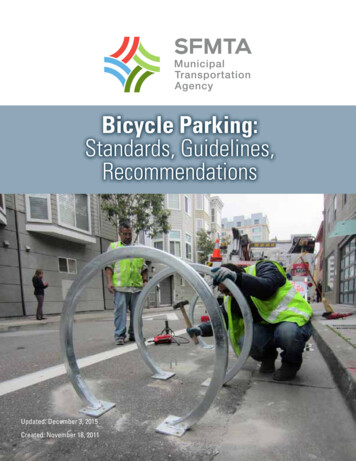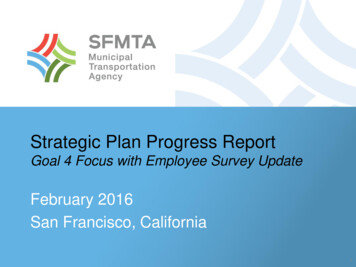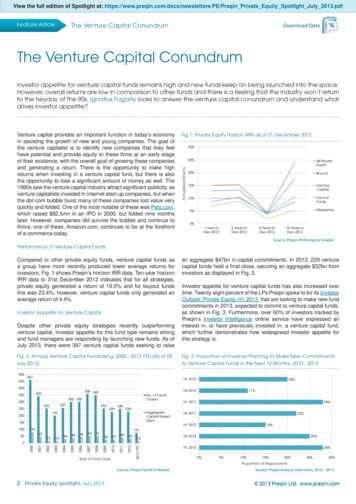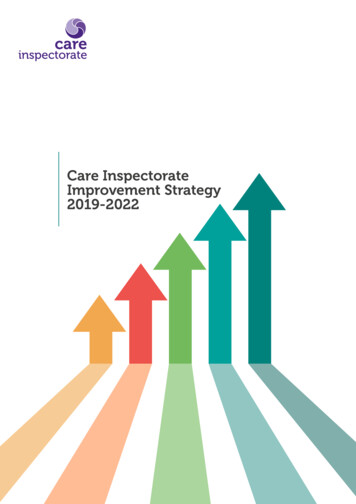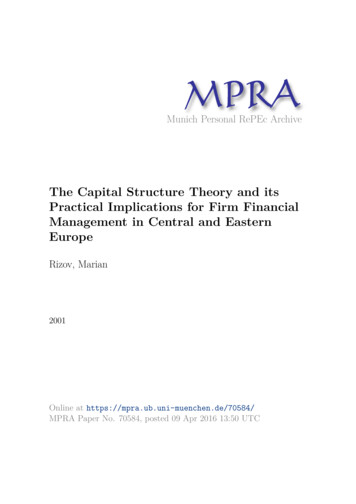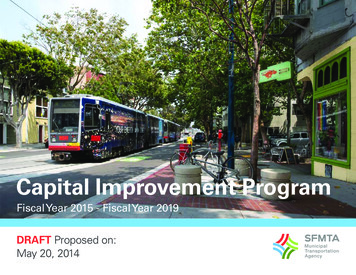
Transcription
Capital ImprovementImprovement ProgramProgramCapitalFiscalYearYear20152013- -FiscalFiscalYearYear20192017FiscalSFMTA.COMDRAFT Proposed on:May 20, 2014SFMTA.COM
ContentsExecutive SummaryThe SFMTA59AboutCore ValuesSFMTA Strategic PlanSFMTA 20-Year Capital PlanSFMTA’s Capital AssetsTransportation 2030Capital Improvement ProgramAboutGoals & PoliciesCIP ProcessCreating & Modifying the CIPCapital Program SummaryCapital Projects MapCommunity InputProject Delivery Phases21Capital Program AreasAccessibilityBicycleCentral SubwayCommunications & iTraffic CalmingTraffic & SignalsTransit Fixed GuidewaysTransit Optimization & ExpansionProject Descriptions175Funding Guide247Appendix269Funding Summary by Capital ProgramFunding SourcesProject Expense by Phase & Capital ProgramCarryforward Funds ICarryforward Funds II
Executive Summary
The CIP Executive SummaryExecutive SummaryThe San Francisco Municipal Transportation Agency (SFMTA) Fiscal Year (FY) 2015-2019 Capital ImprovementProgram (CIP) includes 370 projects for a total investment of 3.30 billion. These projects include infrastructureinvestments as well as various procurements and other one-time initiatives (plans, educational programs,etc.) that improve the safety, reliability and efficiency of the transportation system.2015-2019 CIP: Summary by Capital ProgramCapital ProgramFY 2015FY 2016FY 2017FY 2018FY 2019CIP TotalAccessibility 500,000 1,166,667 4,200,000 3,700,000 5,500,000 15,066,667 33,250,474 33,378,373 25,955,626 12,588,671 14,191,123 119,364,267 244,378,405 150,000,000 150,000,000 150,000,000 98,520,516 792,898,921Communications/ITInfrastructure 36,946,019 4,020,346 1,611,169 900,000 900,000 44,377,534Facility 52,153,043 39,372,520 8,250,000 34,127,480 1,000,000 134,903,043Fleet 229,997,974 321,048,438 199,747,274 205,002,610 124,481,627 1,080,277,923BicycleThe 2015-2019 CIP represents the agency’s second comprehensive effort to present a fiscally constrained fiveyear program of projects.This CIP builds upon the prior FY 2013-2017 CIP, which was successful in defining fundstructures, capital program areas and project phases to be implemented. The purpose of the CIP is to providea greater level of data and transparency. Specific enhancements include expanded project descriptions, moredetailed project schedules, and an index of existing “carryforward” projects, or projects funded in previousyears that will be continued or completed during the five-year CIP period. Cumulatively, these improvementsprovide the public with a useful tool in understanding what projects are planned to occur in the next fiveyears, along with corresponding budgets and timelines.Central SubwayParking 31,935,162 9,144,438------ 41,079,600The CIP was developed through an extensive process that incorporated significant community input, includingpresentations in more than 30 public and city department forums. Feedback from these presentations formedan integral part of the CIP development process, and was integrated into the final proposed CIP for SFMTABoard Adoption. Public outreach will continue to serve an essential role in further defining and improving theprojects listed in this document.Pedestrian 13,585,328 17,653,338 12,280,137 10,391,187 13,262,563 67,172,553School 3,680,295 4,476,395 2,700,112 22,000 22,000 10,900,802Security 5,030,000 10,070,567 10,070,567 3,000,000 3,000,000 31,171,134 910,050 750,000 750,000 750,000 750,000 3,910,050Traffic Calming 7,104,826 9,136,937 2,829,497 2,239,935 1,449,935 22,761,130Traffic & Signals 17,710,375 24,234,665 17,251,834 10,895,679 4,531,250 74,623,803Transit Fixed Guideway 75,067,739 26,727,695 33,084,057 23,946,900 66,085,100 224,911,492 126,130,839 153,891,518 193,332,705 53,627,153 117,649,919 644,632,134 878,380,529 805,071,897 662,062,978 511,191,615 451,344,033 3,308,051,053Building on the goals outlined in the SFMTA’s Strategic Plan and 20-Year Capital Plan, the FY 2015 - 2019 CIPincludes funding for the following: 1) State of Good Repair at an average of 329 million per year, includingfull replacement of the Muni bus fleet, an on-going transit fleet overhaul program, and increased funding fortraffic signals and facilities; 2) Street-related improvements, including significant funding for implementationof the Vision Zero (Bicycle and Pedestrian Strategies); and 3) The Transit Effectiveness Project (TEP), along withan increase in the light rail vehicle and articulated (60-foot) bus fleets.TaxiTransit Opt. & ExpansionFinally, the CIP is a living document and projects are adjusted as needs change. Technical adjustments to theCIP are made on an ongoing basis.Total7
The SFMTASFMTA.COM
The SFMTA Who We Are & What We DoThe SFMTA Who We Are & What We DoThe SFMTAWho We AreThe San Francisco Municipal Transportation Agency,a department of the City and County of San Francisco,is responsible for the management of all groundtransportation in the city. The SFMTA keeps peopleconnected through the San Francisco Municipal Railway(Muni), the nation’s seventh largest public transitsystem. The agency’s additional responsibilities includemanaging parking and traffic, bicycling, walking and theregulation of taxis. With a staff of more than 4,700, theSFMTA’s diverse team of employees is one of the city’slargest with representation by 18 labor organizations.The SFMTA was established in 1999 with the passage ofProposition E, which amended the City Charter to mergeMuni with the Department of Parking and Traffic, creatingan integrated transportation agency to manage citystreets more effectively and advance the city’sTransit Firstpolicy. The SFMTA has continued to evolve by mergingwith the Taxi Commission in March 2009. The agency isgoverned by a Board of Directors, appointed by the10Mayor and confirmed by the Board of Supervisors. TheSFMTA Board of Directors provides policy oversight forthe agency, including approval of its budget and contracts,and approval of proposed changes of fares, fees and finesto ensure that the public interest is represented.What We DoThe SFMTA plans, designs, builds, operates, regulates andmaintains one of the most comprehensive transportationnetworks in the world. The agency directly manages fivetypes of public transit in San Francisco (motor coach,trolley coach, light rail, historic streetcar and cable car)and promotes other forms of transportation includingwalking, bicycling, taxi and auto use. In addition tooverseeing paratransit service for those unable to usefixed-route transit service, the agency also regulatesthe taxi industry and oversees on- and off-street publicparking spaces.11
The SFMTA Who We Are & What We DoThe SFMTA Core ValuesThe SFMTAWith more than 3,500 transit stops, Muni keeps peopleconnected, delivering more than 700,000 passengerboardings on an average weekday and offering unmatchedaccessible transit service to San Francisco’s 800,000 residentsand a workday population of approximately 1.2 million.The SFMTA also manages 450,000 on and off-street parkingspaces, 19 public parking garages and lots, more than 28,000meters, nearly 282,000 street signs and 1,200 traffic signals on946 miles of city streets. The agency is responsible for trafficcalming, pedestrian and bicycle safety, traffic enforcementand the painting and striping of roads, including those thatdefine 217 miles of the city’s growing bicycle network. As apart of the SFMTA’s pedestrian safety initiatives, the agencyalso manages the School Crossing Guard Program to keepchildren safe when crossing city streets.In addition to being an operator and regulator, the SFMTAhas a robust planning, design and construction functionthat supports all elements of the city’s transportationinfrastructure. The SFMTA also provides long-range forecastsfor the agency’s fleets and facilities; the city’s public rights-ofway and their relation to the region; and the transportationimpacts of proposed land use developments with private12Core Valuesdevelopers and other partners. Finally, the SFMTA partnerswith regional transit operators that connect the city withthe region using four additional transit modes (heavy rail,commuter railroad, regional bus and ferry), and with othercity agencies to manage and acquire funding, enhancepedestrian safety, create complete streets projects and beresponsible for the impacts of the transportation network onthe environment.SFMTA’s transit fleet is the greenest in the nation, with 52percent of its bus and rail fleet composed of zero-emissionvehicles. Muni accounts for 17 percent of all trips madein San Francisco, but only one percent of total citywidegreenhouse gas emissions. The SFMTA also regulates thegreenest taxi fleet in the country and is continually improvingthe pedestrian and bicycling experience in San Francisco toencourage the use of sustainable transportation modes withlow environmental and positive public health impacts. Byperforming these multiple essential functions, the SFMTAdirectly touches every person who lives, works in or visitsthe city, and positively impacts regional efforts to achieveCalifornia’s climate and sustainability goals, quality of lifeand economic vitality.Vision: San Francisco: great city, excellent transportation choices.Mission: We work together to plan, build, operate, regulate, and maintainthe transportation network, with our partners, to connect communities.Our Core Values:For the transportation network:For the team: Transit First: Transit, walking, bicycling, taxi,carsharing, and ridesharing have the highestpriority Leadership: Realizing and implementing the vision tothe fullest Complete and Green Streets: Streets aredesigned and managed to be attractive,inviting public spaces for peopleTeamwork: Working together in partnership to provideexcellent customer service Integrity: Working with the highest standards ofhonesty and ethics Accountability: Taking joint responsibility to set andmeet or exceed the Agency’s goals Effectiveness: Achieving results through collaborationand efficient use of resources Respect: Holding those with and for whom we work inhigh esteem and regard Green, Clean, and Quiet Mobility: Usethe greenest, most efficient, and quietesttechnologies available Social Equity and Access: Prioritize the mostaffordable and accessible modes13
The SFMTA Strategic PlanThe SFMTA Capital PlanSFMTA 20-Year Capital PlanSFMTA Strategic PlanBy 2035, San Francisco is projectedto have approximately 15% growthin population and 25% growth inemployment. This growth requiresus to rethink our resources andtools to meet the city’s quality of lifeobjectives. SFMTA can leverage itsmulti modality to facilitate big pictureplanning,design,construction,operations and overall fundingmanagement to implement completestreets projects that make non-automodes more attractive to all residents,workers and visitors to San Francisco.Under the Strategic Plan, the SFMTAis committed to a mode share goal of50% auto and 50% non-auto (transit,bicycling, walking and taxi) for alltrips by 2018. Meeting this modeshift goal will put the SFMTA andthe city as a whole on track to meetthe transportation needs of futureresidents, employees and visitors.The SFMTA Strategic Plan’s four overarching goals will shape how theAgency prioritizes its attention, resources and staff over the next 6 fiscalyears: Create a safer transportation experience for everyone. Make transit, walking, bicycling, taxi, ridesharing and carsharingthe preferred means of travel. Improve the environment and quality of life in San Francisco. Create a workplace that delivers outstanding service.14The Capital Plan is the catalog ofthe SFMTA’s anticipated capitalneeds for the upcoming 20 years. Itis a financially unconstrained planand includes capital project needsfor which funding has not yet beencommitted. The purpose of the planis to identify the agency’s capitalinvestment needs and establishwhich investments are the highestpriorities for the agency. All of theagency’sinvestmentdecisions,grant applications, and projectprioritization rely upon the programsdescribed in the plan.A major component of the CapitalPlan is the identification of existingassets in need of replacement in thenext 20 years. The 2010 SFMTA Stateof Good Repair Report was the firstmodern accounting of all the agency’sassets and their replacement costs.SFMTA has continued to refine thisinformation and plans to implementa comprehensive Enterprise AssetManagement System in the comingyears. In the meantime, the qualityof data and level of detail used inassessing the agency’s state of goodrepair needs will continue to evolve.The Capital Plan is used by all levelsof SFMTA staff, local and regionaltransportation funding and policybodies, other City and County of SanFrancisco Departments, advocacyand stakeholder groups, and thegeneral public. Although inclusion inthe Capital Plan does not guaranteefunding or approval of any particularproject or program contained withinit, having clear and consistentlystated capital needs are critical toSFMTA’s ability to secure federal,state, regional, and local funding.15
The SFMTA’s Capital AssetsA visual summary of the agency’s capital inventory being maintained & upgraded through theSFMTA’s Capital Improvement Program.40 cable cars151 light rail vehicles19 facilities35 historic streetcars8.8 mile of cable car tracks28,862parking meters40 off-streetparking garages1625 milesfor operations,maintenance &administrativeresponsibilities71 miles of light rail tracks400,000 public parking spaces505 hybrid/diesel 311 trolley busesof overhead wires14.8 milesof priority lanes1,088 miles of streets1,193signalizedintersections281,000street signs215 miles of bicycleroutes, paths & lanes3,060 bike racks on sidewalks202 racks in on-street corrals35bikesharing stations, with 350 bikes17
Transportation 2030A 1.5 billion funding package to improve road conditions, transit service and street safety in San Francisco.What is transportation 2030?Transportation 2030 is a strategic infrastructure investment program proposed for San Francisco’s November2014 ballot. Through three ballot measures and two funding sources, Transportation 2030 will provide 1.5billion to complete hundreds of transportation infrastructure projects throughout the city by 2030. If passedby the Board of Supervisors this summer, San Francisco voters will vote on the three Transportation 2030ballot measures on November 4, 2014. If passed, the three measures would create two funding sources – oneshort-term and one long-term – to invest in a variety of strategic, meaningful local transportation infrastructureprojects. The measures are:BETTER ROADSThe following table displays the impact of Transportation 2030 (T2030) funds by CapitalProgram in the 5-Year CIP. For more information, see Appendix.Capital ProgramNon-T2030Total 13,466,667 1,600,000 15,066,667Bicycle 32,024,777 87,339,490 119,364,267Central Subway-- 792,898,921 792,898,921Communications/ITInfrastructure-- 44,377,534 44,377,534Facility 74,000,000 60,903,043 134,903,043Fleet 65,950,000 1,014,327,923 1,080,277,923-- 41,079,600 41,079,600 32,841,497 34,331,056 67,172,553School-- 10,900,802 10,900,802 More dependable transit service and a more comfortable ride Reduced long term cost to maintain roads in good condition, which means taxpayersavings 20% faster Muni service on the most heavily utilized linesSecurity-- 31,171,134 31,171,134Taxi-- 3,910,050 3,910,050Traffic Calming-- 22,761,130 22,761,130 Fewer Muni delays at intersections and corridors through 40 miles of transitinvestmentsTraffic/Signals 14,583,333 60,040,470 74,623,803-- 224,911,492 224,911,492Transit Optimization/Expansion 262,375,000 382,257,134 644,632,134Total 495,241,274 2,812,809,779 3,308,051,0532, The restoration of the vehicle license fee to 2% to provide a long-term source of funding for transportationinfrastructure projects in San Francisco. For vehicles registered to San Francisco addresses, the VLF wouldincrease from 0.65% to 2%, its traditional level from 1948 to 1998. VLF revenue would go to the San FranciscoGeneral Fund.A policy statement recommending the new General Fund revenue be directed to transportation projects.improved transitSAFer streetsParkingPedestrianWhat does Transportation 2030 mean for you? Replace out-of-date buses and trains to improve service and reduce crowding forpassengers18T2030Accessibility1.A 500 million General Obligation Bond to fund urgent repairs and upgrades to the city’s transportationinfrastructure without raising the city’s property tax rate.3.Transportation 2030 and the 5-YEAR CIPTransit Fixed Guideway19
The CapitalImprovementProgramCapitalImprovementProgram
The CIP AboutThe CIP AboutCapital Improvement ProgramThe SFMTA Fiscal Year (FY) 2015-2019 Capital Improvement Program (CIP) includes 370 projects for a totalinfrastructure investment of 3.30 billion. Projects include infrastructure investments as well as variousprocurements and other one-time initiatives (plans, educational programs, etc.) throughout the city.The Capital Improvement Program: Develops a financially constrained 5-Year Program of Projects for the Transportation System Reviews and projects 5-Year Capital Revenue Sources Develops a Strategic Investment/Value Analysis for project prioritization and funding Serves as an implementation tool for the SFMTA Strategic Plan and other Plans and Strategies Prevents funding accessibility from being a barrier to project delivery Builds credibility with external funding agencies (e.g. MTC, FTA) Works toward a 10% Capital Fund Reserve allowing for flexibility and a buffer against revenueuncertaintyProjects that are included in the 5-Year CIP are identified by various staff within the SFMTA based upon thefollowing: (1) Input from the community received at various public meetings; (2) input from the SFMTABoard of Directors, San Francisco Board of Supervisors (or the BOS sitting as the Transportation AuthorityBoard) and other commissions and advisory committees; (3) the SFMTA Board or other City and Countyof San Francisco approved plans for growth, improvements, and rehabilitation; (4) SFMTA Board adopted20-Year Capital Plan and attached prioritization criteria for selecting priority needs to advance policy goals;and (5) staff-identified projects based on critical need due to safety issues or to comply with new mandates.The following pages contain detail on CIP goals, policies, processes and the 15 Capital Program Areas.2223
The CIP Goals & PoliciesThe CIP ProcessGoals & PoliciesCIP ProcessThe FY 2015-2019 Capital Improvement Program is formulated around three key policy directives:The FY 2015-2019 Capital Improvement Program matches existing priorities, plans, strategies and public inputalongside projected funding availability and project prioritization criteria.1.2.3.Maintain and build upon 250M per year State of GoodRepair (SOGR) investmentMaintain and increasefunding in Safe andComplete StreetsFund critical Transit TravelTime and Reliability Projects Ensure full funding for MuniFleet Replacement Increase funding for TrafficSignal SOGR from historic base Initiate an ongoing Muni FleetMid-Life Overhaul Program Fund critical Facility Replacementneeds Continue to upgrade andmaintain Muni Fixed Guidewayassets, including traffic signals Integrate recommendations fromWalkFirst/Ped Strategy Integrate recommendations fromthe SFMTA Bicycle Strategy Increase investment in TrafficCalming to reduce currentbacklog of projects Deliver on policy goalsestablished by Vision Zero Fund Priority Travel TimeReliability and Customer FirstProjects Integrate and fundimprovements on Market Street Increase funding for FleetExpansion (LRV, articulated busfleet)24Policy Priorities, Plans,Strategies & Public InputFunding Identification& Project Prioritization SFMTA Strategic PlanFunding constraintsSFMTA 20-Year Capital PlanCompetitive Grant ProposalsVision Zero & Pedestrian StrategyProposition K Local Sales TaxBicycle StrategyCity General Fund, Developer FeesFleet PlanSFMTA Revenue BondsReal Estate & Facilities VisionMTC Regional GrantsSF Adopted Area PlansOther Sources (Fed., State, Local)SF County Transportation PlanpROJECT pRIORITIZATIONNeighborhood Transportation PlansCIPCIPCIPSFMTA FY 2015-2019Capital ImprovementProgram (CIP)is the fiscallyconstrained funding planfor delivery of projects25
The CIP ProcessCreating & Modifying the CIPThe CIP ProcessCIP ProcessSFMTA Board ApprovesHow does a capital need become an investment included in the CIP?See process diagram to the right.Capital Needidentified by stakeholdersCapital needs identified by stakeholders and SFMTA staff are evaluated by the TransportationCapital Committee, which is made up representatives from each of the SFMTA divisions. TheTransportation Capital Committee meets monthly to consider any changes to the Capital Planor Capital Improvement Program (CIP). The TCC is responsible for approving new capitalneeds for inclusion in the Capital Plan and prioritizing needs based on criteria establishedby the Director of Transportation / Leadership Team. All Capital Needs must be in the CapitalPlan to be considered for inclusion in the CIP. The TCC is also responsible for approving capitalproject scopes, schedules, budgets and funding plans. Once a project is included in the CIP,modifications within a certain threshold can be made by the Capital Financial Planning andAnalysis (CFPA) group of the Finance & Information Technology Division (FIT).The CIP is a dynamic document and projects are adjusted asneeds change. Technical adjustments are made continuously.26& SFMTA staffSFMTA’s Long-RangePlanning groupreviews need, includingdescription & costs. OffersTransportationCapital Committee20-YearCapital Planreviews recommendationfinanciallyfor inclusion in Capital Planunconstrainedplan of all needsrecommendation to TCCCapital FundingRequest (CFR)TransportationCapital Committeescope, schedule & budget ofSFMTA’s CapitalFinancial Planning &Analysis (CFPA) groupreviews recommendation5-Year CapitalImprovementProgram (CIP)prioritized project in Capitalreviews request, matchesfor inclusion in CIPfinancially constrainedPlan submitted to CFPAappropriate funds, & offersprogram of projects.recommendation to TCCFirst 2 years of CIP Capital Budget27
The CIP Capital Program AreasThe CIP Capital Program AreasCapital Program SummaryThe CIP is comprised of 15 Capital Programs as listed in the table below. These programs were designed toensure investments in line with the agency’s strategic goals and priorities.Program NameDescriptionProgram NameDescriptionAccessibilityPlan, design, and construct improvements to improve the accessibility of the transportation system in SanFranciscoSchoolPlan, design, and engineer improvements to streets in school zones to enable safe travel to school for childrenwho walk and bikeBicyclePlan, design and construct bicycle facilities including bicycle lanes, bicycle tracks, and bicycle parking. Supportbicycle-related safety and education programs.SecurityPlan, design, and construct or implement systems to improve the security of the transit systemTaxiPlan, design, and construct or implement infrastructure and systems to optimize the taxi system in SanFrancisco to provide better experienceTraffic CalmingPlan, design, and construct street redesign projects to address traffic problems and improve safety for allTraffic / SignalsPlan, design, engineer, and construct infrastructure and traffic signals to decrease transit travel time andimprove mobility and safety of San Francisco roadwaysTransit Fixed GuidewayPlan, design, and construct transit improvements to rail track, overhead wires, and train control technologyTransit Optimization /ExpansionPlan, design, engineer, and construct infrastructure to improve travel time and reliability of the transit system,including expansion of the transit systemCentral SubwayPlan, design, engineer, and construct the T-Third Line Phase II extension from Fourth and King to ChinatownFacilityAcquire, develop, and/or rehabilitate transit station areas and maintenance facilities used for transit, traffic,and parking operationsFleetPurchase buses, trains, and support vehicles for transit and sustainable street needsInformation Technology/ CommunicationsPlan, design, and implement technology infrastructure to improve the efficiency and effectiveness of theSFMTA and provide a better user experienceParkingPlan, design, rehabilitate, and construct public parking facilities or street infrastructure related to public parkingPedestrianEducate, plan, design, and construct pedestrian improvements to promote walking and improve safety2829
The CIP Capital Projects MapSFMTA Capital InvestmentsCapital Projects MapCIP Fiscal Year 2015 - 2019The Capital Projects Map gives an overview of some of SFMTA’s geographic-specific capital investments. Pleaserefer to the following capital program areas for a complete list of all capital investments over FY 2015-2019 CIP period.The FY2015-2019 CIPBicycle370 Capital ProjectsPedestrianSchool15 Capital ProgramsTraffic Calming 3.30 BillionTotal Investment 286 Carryforward Projects:In addition to implementing the 370 projects that will receive new funding sources during the FY2015-2019 CIP period,the SFMTA is also currently implementing 286 existing “carryforward” projects that have already been fully funded. Thesecarryforward projects have 417 million in remaining funds to be invested as of March 2014, and the SFMTA will continue toimplement these projects during the next CIP period. Please see Appendix Table 5 for a summary of carryforward projectsthat were fully funded before the FY 2015-2019 CIP period.30AccessibilityTransit Fixed GuidewaysTransit OptimizationTraffic & SignalsParkingFacility* Note: Citywide and non-geographic-specific projects excluded from map.See program areas for more info.
The CIP Community InputThe CIP Project Delivery PhasesCommunity InputProject Delivery PhasesThe CIP was developed based on extensive community input. In total, the SFMTA made over 30presentations to various public and City partner groups. Feedback from committees such as thoselisted below were an integral part of the CIP development process, and were integrated into the finalproposed CIP for SFMTA Board Adoption.The FY 2015-2019 Capital Improvement Program includes 370 projects in 15 capital program areas to be delivered overvarious phases. Each capital program area section of this document includes a Gantt chart to show when and at whatphase projects are expected to be delivered; phasing allows projects to be funded and delivered appropriately. Balboa Park Citizens Advisory Committee Bicycle Advisory Committee Eastern Neighborhood Citizens Advisory Committee Market & Octavia Citizens Advisory Committee Pedestrian Safety Advisory Committee SFMTA Citizen’s Advisory Council Small Business Commission Streets Capital Group Transportation Authority Citizens Advisory Committee Transportation Authority Plans and Programs Committee321. Pre-development/ PlanningPre-development & preliminary planning, including identification of project team and developmentof the project scope, schedule & budget.Key Action: Confirmed project scope & charter2. CERAddressing environmental issues, user concerns, maintenance requirements, alternativeanalyses, etc. for the Conceptual Engineering Report (CER)Deliverable: CER with conceptual plans (10-30% design)3. EnvironmentalMeeting environmental standards put forth by the California Environmental Quality Act (CEQA)and or the National Environmental Policy Act (NEPA), including development of an EnvironmentalImpact Report (EIR) or Environmental Impact Statement (EIS) if relevant.Key Action: EIR/EIS if applicable4. DesignImplement conceptual engineering plans and produce final design specifications. Also includespreparation of engineer’s estimates, contract packages, and analysis of construction bids.Deliverable: Construction ready designs & plans5. Construction/ ProcurementConstruction and management of the project, ensuring work is constructed in accordancewith drawing specifications and thorough inspections. For Muni fleet, this phase denotes theprocurement of vehicles.33
Capital Program Areas
CIP Program Areas AccessibilityCIP Program Areas AccessibilityAccessibility12 projects, 15M investmentPlan, design, and construct capital projects to enhance the accessibility of thetransportation system.SFMTA strives to make public transportation accessible to every person in SanFrancisco. This requires planning, designing, and constructing capital projects toenhance the accessibility of the transportation system, such as installing accessibleelevators at transit stops or constructing ‘boarding islands’ that provide easierboarding onto buses and trains.These improvements benefit a broad spectrum of San Francisco residents andvisitors. Families traveling with small children in strollers, for example, can moreeasily board transit vehicles and stations. Those who may be temporarily disabledfrom an injury will enjoy easier access. And those who are permanently disabled orwheelchair dependent will enjoy consistent access to the transportation network.Improved transit accessUpgraded facilitiesBetter transit experienceThe Accessibility Program is dedicated to projects that go above and beyond basicAmericans with Disabilities Act (ADA) requirements to make all modes and aspectsof the transportation system accessible - from buses to streetcars to transit stops.Accessibility improvements are at the core of the SFMTA’s Capital ImprovementProgram and are not limited to the projects listed on the following pages, but areincorporated into the design of many projects in the other Capital Programs.3637
CIP Program Areas Accessibility38CIP Program Areas AccessibilityAccessibility ProjectsAccessibilit
The 2015-2019 CIP represents the agency's second comprehensive effort to present a fiscally constrained five-year program of projects. This CIP builds upon the prior FY 2013-2017 CIP, which was successful in defining fund structures, capital program areas and project phases to be implemented. The purpose of the CIP is to provide
